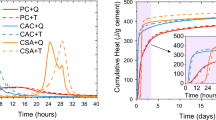Abstract
The alkalinity of Portland cements is responsible for precipitation and low solubility of many radwaste species. The sources of alkalinity are evaluated and two chemical models, based on experimental and theoretical data presented enabling the effect of blending agents (PFA, silica fume, etc.) to be evaluated and the alkalinity of the system at longer ages predicted. The data take the form of a solubility model which is applicable to non-heat generating wastes.
Similar content being viewed by others
References
S.A. Greenberg, T.N. Chang and E. Anderson, J. Phys. Chem., 64 1151–1157, (1960).
S.A. Greenberg and T.N. Chang, J. Phys. Chem., 69, 182–188 (1965).
J. Marr and F.P. Glasser, 6th Intl. Conf. on Alkalis in Concrete, (Ed. G.M. Idorn and S. Rostam: pub. DBF, Copenhagen), pp 239–242, (1983).
G.Y. Shin and F.P. Glasser, Cement and Concr. Res., 13, 366–376 (1983).
K. Fujii and W. Kondo, J.C.S., Dalton Trans., 2, 645–651, (1981).
H.F.W. Taylor and J.W. Howison, Clay Minerals Bull., 3, 98–111, (1956).
H.F.W. Taylor, J. Chem. Soc., (London) No. 726, 3682–3690, (1950).
Author information
Authors and Affiliations
Rights and permissions
About this article
Cite this article
Glasser, F.P., Angus, M.J., McCulloch, C.E. et al. The Chemical Environment in Cements. MRS Online Proceedings Library 44, 849–858 (1984). https://doi.org/10.1557/PROC-44-849
Published:
Issue Date:
DOI: https://doi.org/10.1557/PROC-44-849




